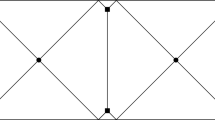Abstract
If a continuous function f is approximated by elements of a Haar space in the maximum norm on an interval, the error curve of the best approximation has well known alternation properties. It is shown that if f is adjoined to the Haar space all zeros of the error function are monotonously increasing functions of the endpoints, and that under an additional hypothesis, the entire graph of the error curve is shifted to the left or right when the endpoints are moved accordingly.
Similar content being viewed by others
References
Cheney, E.W.: Introduction to Approximation Theory, McGraw-Hill, New York 1966.
Karlin, S. and Studden, W.J.: Tchebychev Systems: With Applications in Analysis and Statistics, John Wiley and Sons, New York 1966.
Streit, R.: Extremals and Zeros in Markov Systems are Monotone functions of one endpoint, J.Approximation Theory, to appear.
Zielke, R.: On Transforming on Tchebyshev-System into a Markov-System. J.Approximation Theory, 9 (1973), 357–366.
Zielke, R-: Alternation Properties of Tchebyshev-Systems and the Existence of adjoined functions, J.Approximation Theory, 10 (1974), 172–184.
Zielke, R.: Tchebyshev-Systems that cannot be Transformed into Markov-Systems, Manuscripta Mathematica, 17 (1975), 67–71.
Author information
Authors and Affiliations
Rights and permissions
About this article
Cite this article
Zielke, R. Concertina-like movements of the error curve in the alternation theorem. Manuscripta Math 22, 229–234 (1977). https://doi.org/10.1007/BF01172665
Received:
Issue Date:
DOI: https://doi.org/10.1007/BF01172665



